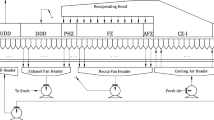Abstract
Rotary kiln process for iron ore oxide pellet production is hard to detect and control. Construction of one-dimensional model of temperature field in rotary kiln was described. And the results lay a solid foundation for online control. Establishment of kiln process control expert system was presented, with maximum temperature of pellet and gas temperature at the feed end as control cores, and interval estimate as control strategy. Software was developed and put into application in a pellet plant. The results show that control guidance of this system is accurate and effective. After production application for nearly one year, the compressive strength and first grade rate of pellet are increased by 86 N and 2.54%, respectively, while FeO content is 0.05% lowered. This system can reveal detailed information of real time kiln process, and provide a powerful tool for online control of pellet production.
Similar content being viewed by others
References
STEPHAN K D, WANG Ling-yun, RYZA E. Microwave radiometry for cement kiln temperature measurements [J]. Journal of Microwave Power and Electromagnetic Energy, 2007, 40(3): 140–144.
DU Qi-liang, MO Hong-qiang, MAO Zong-yuan, LIN Jun. Infrared temperature measurement and analysis in a barium sulphide rotary kiln [J]. Chinese Journal of Scientific Instrument, 2007, 28(8): 1492–1496. (in Chinese)
XIAO Chun, CHEN Jing, YUAN You-xin, HUANG Bi-hui, LI Jia. Research on kiln body health monitoring of ceramic roller kiln with oxygen-enriched and pure oxygen combustion [C]// 2008 Pacific-Asia Workshop on Computational Intelligence and Industrial Application. Wuhan, 2008: 607–611.
HOGAN H. Accent on applications: Digital imaging enables researchers to take a kiln’s temperature without getting burned [J]. Photonics Spectra, 2006, 40(8): 34.
BOATENG A A. Rotary kilns [M]. Oxford: Butterworth-Heinemann, 2008: 205–238.
MASTORAKOS E, MASSIAS A, TSAKIROGLOU C D, GOUSSIS D A, BURGANOS V N, PAYATAKES A C. CFD predictions for cement kilns including flame modelling, heat transfer and clinker chemistry [J]. Applied Mathematical Modelling, 1999, 23(1): 55–76.
LIU Jiao-yu, CHEN Kun, DENG Yi. Simulation of the atmosphere-temperature decoupling system on grey predicting PID control of the gas-burning roller ceramic kilns in SIMULINK [C]// Proceedings of the 9th International Conference on Electronic Measurement & Instruments, Beijing, 2009: 3742–3746.
MOHANTY D, CHANDRA A, CHAKRABORTI N. Genetic algorithms based multi-objective optimization of an iron making rotary kiln [J]. Computational Materials Science, 2009, 45(1): 181–188.
ZHANG Hong-liang, ZOU Zhong, LI Jie, CHEN Xiang-tao. Flame image recognition of alumina rotary kiln by artificial neural network and support vector machine methods [J]. Journal of Central South University of Technology, 2008, 15(1): 39–43.
GUO Feng, LIU Bin, HAO Xiao-chen, GAO Peng. Research on the fuzzy predictive control for calcining temperature of the rotary cement kiln [C]// 10th International Conference on Signal Processing Proceedings. Beijing, 2010: 2568–2571.
MA Ai-chun, ZHOU Jie-min, SUN Zhi-qiang, LI Wang-xing. A one-dimensional thermal model for the alumina clinker kiln [J]. Energy for Metallurgical Industry, 2004, 23(1): 23–26. (in Chinese)
BARR P V, BRIMACOMBE J K, WATKINSON A P. A heat-transfer model for the rotary kiln: Part II. Development of the cross-section model [J]. Metallurgical Transactions B, 1989, 20(3): 403–419.
GOROG J P, ADAMS T N, BRIMACOMBE J K. Heat transfer from flames in a rotary kiln [J]. Metallurgical Transactions B, 1983, 14(3): 411–424.
GOROG J P, ADAMS T N, BRIMACOMBE J K. Regenerative heat transfer in rotary kilns [J]. Metallurgical Transactions B, 1982, 13(2): 153–163.
PETRICA VIZUREANU. Expert systems[M]. Vukovar: Intech, 2010: 47–64.
Author information
Authors and Affiliations
Corresponding author
Additional information
Foundation item: Project(NCET-05-0630) supported by Program for New Century Excellent Talents in University of China
Rights and permissions
About this article
Cite this article
Fan, Xh., Wang, Y. & Chen, Xl. Mathematical models and expert system for grate-kiln process of iron ore oxide pellet production. Part II: Rotary kiln process control. J. Cent. South Univ. Technol. 19, 1724–1727 (2012). https://doi.org/10.1007/s11771-012-1199-7
Received:
Accepted:
Published:
Issue Date:
DOI: https://doi.org/10.1007/s11771-012-1199-7



